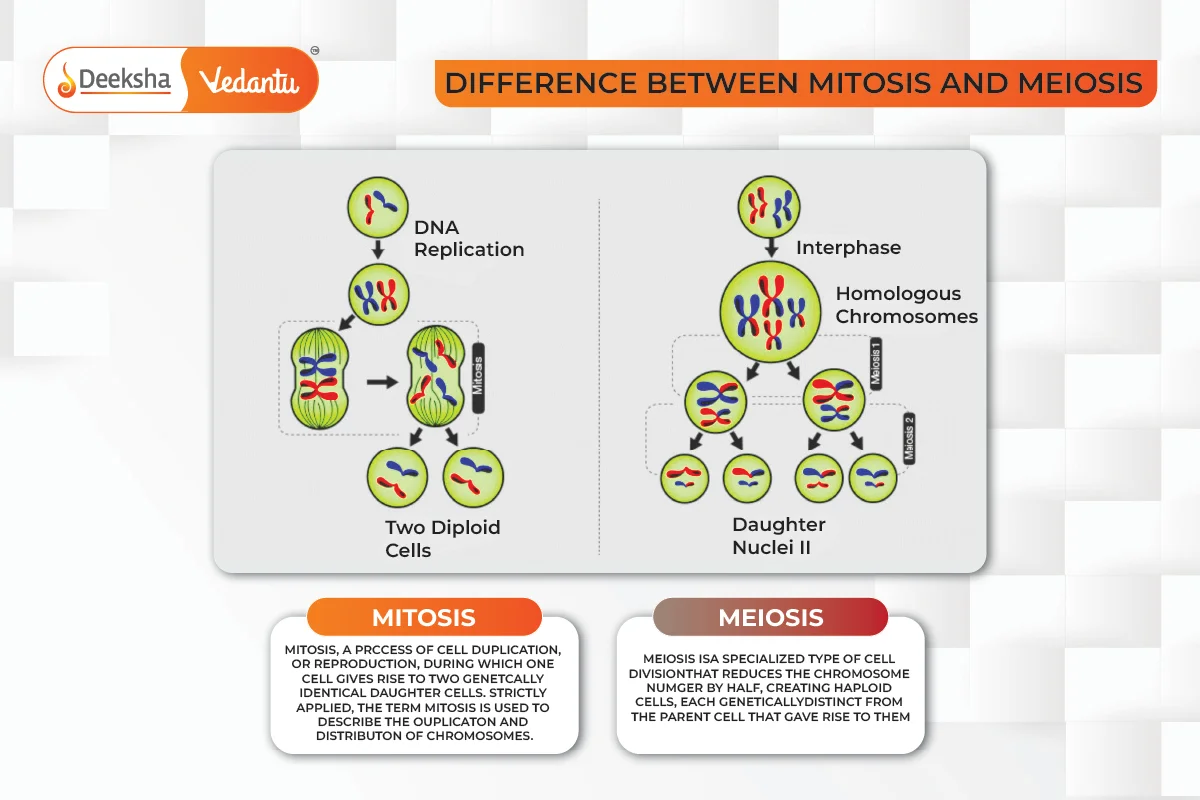Introduction to Cellular Division: Mitosis vs. Meiosis
Cell division is a fundamental process in all living organisms. It occurs in two distinct forms: mitosis and meiosis. While both processes involve the division of a cell’s nucleus, they serve different purposes and occur in different types of cells. Mitosis results in two identical daughter cells, each with the same number of chromosomes as the parent cell, making it crucial for growth, repair, and asexual reproduction. Meiosis, on the other hand, results in four daughter cells, each with half the number of chromosomes, which is essential for sexual reproduction and genetic diversity.
Detailed Comparison of Mitosis and Meiosis
Mitosis: The Basics
- Role and Function: Mitosis is involved in growth, cellular repair, and asexual reproduction across all living cells.
- Phases: The process includes four main stages: prophase, metaphase, anaphase, and telophase.
- Chromosomal Behavior: During mitosis, chromosomes duplicate and the sister chromatids are pulled apart to opposite ends of the cell, ensuring each new cell has a complete set of chromosomes.
Meiosis: The Basics
- Role and Function: Meiosis is critical for sexual reproduction and occurs in the germ cells to produce gametes (sperm and eggs).
- Phases: Meiosis consists of two rounds of division: meiosis I and meiosis II. Meiosis I reduces the chromosome number by half (reduction division), while meiosis II resembles a mitotic division.
- Chromosomal Behavior: Meiosis introduces genetic diversity through the random assortment of chromosomes and crossing over between homologous chromosomes.
Key Differences Between Mitosis and Meiosis

- Function:
- Mitosis is used for the growth and maintenance of cells within an organism.
- Meiosis facilitates genetic diversity and the production of gametes for reproduction.
- Number of Divisions:
- Mitosis involves a single division resulting in two daughter cells.
- Meiosis involves two successive divisions resulting in four genetically unique daughter cells.
- Chromosome Number:
- Mitosis preserves the chromosome number of the original cell.
- Meiosis reduces the chromosome number by half, producing cells that are haploid.
- Genetic Variability:
- Mitosis produces genetically identical cells.
- Meiosis generates genetic variability through independent assortment and crossing over.
- Stages of Division:
- In mitosis, chromosomes line up individually at the metaphase plate before being separated.
- In meiosis, homologous chromosomes pair up and line up together before being separated in meiosis I.
Similarities Between Mitosis and Meiosis
Despite their differences, mitosis and meiosis share several key features:
- Both processes include the stages of prophase, metaphase, anaphase, and telophase.
- DNA replication precedes both types of cell division during the S phase of interphase.
- Both involve the breakdown of the nuclear membrane and the formation of new nuclei.
The Impact of Mitosis and Meiosis on Life
Understanding the differences between mitosis and meiosis is crucial for comprehending how organisms grow, develop, and reproduce. Mitosis is vital for the day-to-day maintenance and growth of an organism, while meiosis ensures the continuity of species through generations, contributing to genetic diversity and adaptation.
Conclusion
Mitosis and meiosis are pivotal biological processes that support life through growth and reproduction. Their distinctions underscore the complexity of cellular functions and the sophisticated mechanisms that underpin life on Earth.
FAQs
Yes, mitosis occurs in almost all eukaryotic cells, excluding germ cells which undergo meiosis.
Both mitosis and meiosis involve prophase, metaphase, anaphase, and telophase as part of their processes.
Meiosis produces gametes with half the chromosome number of parent cells, essential for sexual reproduction and ensuring genetic variation in offspring.
Meiosis introduces genetic diversity through processes like crossing over and independent assortment during the formation of gametes.
Mitosis serves to grow and repair tissues by producing two identical daughter cells from a single parent cell.
Related Topics
- Coordination In Plants
- Eco-System – What Are Its Components?
- Human Respiratory System
- How do Organisms Reproduce?
- Kingdom Fungi
- Plant Cell
- Nutrition
- What Are Life Processes?
- Respiration
- Mitosis
- Life Processes
- Biodiversity
- Modes Of Reproduction Used By Single Organisms
- Human Digestive System
- Overview of Food Chain












Get Social